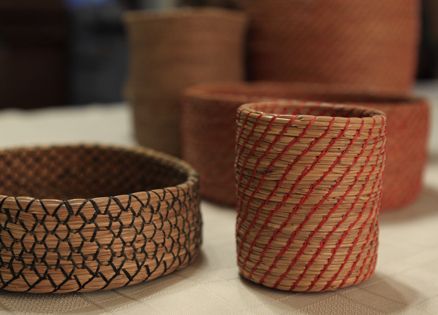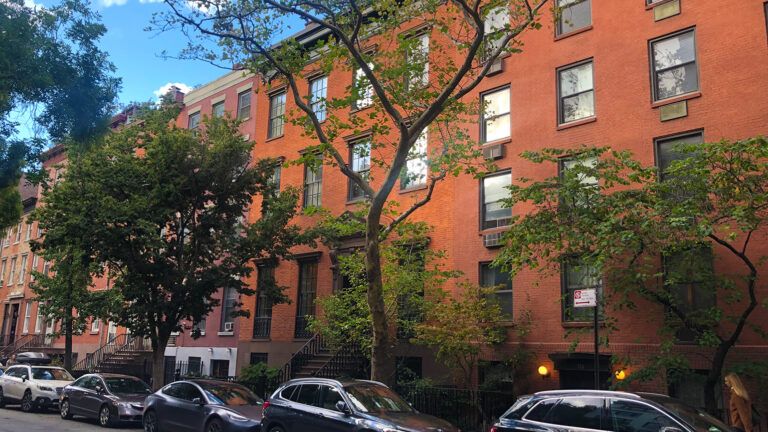To help keep my promise to Jane Bigelow, who bought my first basket then most generously gave it back to me, I’d like to share instructions on making a pine needle basket.
Please don’t let the number of steps intimidate you! Be patient. It may seem complicated at first, but once you get into the rhythm of the weave, it becomes easy to let your fingers work the materials while your mind drifts off to other matters.
Occasionally I’ll work on a basket in front of the TV, but more often it’s a time to sit back and mull over a situation, or simply rejoice in a quiet moment. I find basketry relaxing, especially after a hectic day. Sometimes, the hardest part is stopping!
Note: There’s a link to a downloadable PDF of these instructions below, along with a link to a video that demonstrates the actions described here.
Suppplies
| Brown pine needles (at least 6 inches long) from dead trees or from the ground | 1 ½ inch piece of plastic soda straw |
| Scissors | Paper towels |
| Artificial sinew | Half-gallon plastic bag (for the pine needles and basket if you take more than a day to create) |
| Tapestry needle | Clear polyurethane spray paint |
| Pliers (to insert your tapestry needle through the pine needle coils when it is too hard to push the needle through by hand) | Patience! |
Instructions
1. Soak the pine needles in water overnight (8-12 hours).
2. Remove and cut the caps off the end of the pine needles.
3. Cut a six-foot-long piece of artificial sinew. Most sinew that you can buy is too wide so you’ll need to split the strand into 3 or 4 pieces. Set aside all but one.
4. Fill the soda straw with pine needles. Then cut the ends of the pine needles so that they stick out evenly 2 inches from one end of the straw.
5. To start the core of your basket tie the sinew around the pine needle bundle approximately 1/4 inch from the cut end of the pine needles. A square knot is an effective knot to use.
6. Cut the loose end of the sinew to about an inch long and lay it against the pine needles.
7. Starting at your knot and working towards the straw, wrap the pine needles and the loose end of the sinew tightly with sinew, completely covering the pine needles with sinew for one inch.
8. Thread your needle with the sinew.
9. Gently bend the pine needles back around against the sinew-wrapped pine needles.
10. Pull your thread tight. Bring the sinew from the front of your basket, over the bare pine needles that you are adding and then on the back side of your basket. Pierce the sinew-covered pine needles 1/8 inch from where you started wrapping the pine needles. Pull your needle all the way through and pull the thread tight.
11. Continue curling the pine needles around the sinew-wrapped coil, making stitches every 1/8 inch. Each stitch should be made by bringing the sinew from the front of your basket, over the pine needles that you are adding and then piercing the coil underneath the one that you are adding on the back side of your basket. Make sure that you pull your stitches as tight as you can because when the pine needles dry they will shrink.
Whenever the plastic straw is in your way to make a stitch, slide it farther down the pine needles that you are adding. Whenever there is room to add more pine needles into the end of the straw, do so. Keep the same amount of pine needles gathered together, so that the amount in each coil is consistent throughout your basket.
12. Once you have stitches all the way around your basket, the stitches that you add will pierce your stitches on the previous coil.
13. Once you only have a few inches of sinew left, tie a new strand of sinew to the end with a square knot. Make sure that your finished knot ends up where the next coil will cover it up. Take the loose ends of the sinew and hold them against the pine needles. When you make your next few stitches, it will hold the loose ends in place to be covered up by your next coil.
14. Continue on until the base of your basket is complete. Whenever your stitches are more than 3/8 to 1/2 inch apart, add a stitch between them.
15. Once the base is complete, change the angle that your needle goes through the previous coil in order to hold the new coil at the angle you want it.
16. Keep working up the sides until the basket is the size you want it. Plan ahead and make sure that you won’t have any knots left to cover up on your last round. Remove the straw and let the pine needles taper off.
17. Once you only have three or four pine needles left, it’s time to end your basket. Pull your last stitch really tight. Then tie a knot (half hitches work well here) around the inside of the stitch under your last stitch. Then from the inside of your basket take a stitch to the outside of your basket through your last stitch. Pull really tight, and your knot will be pulled under your last coil. Cut the sinew off outside your basket as close to the basket as you can.
18. Let your basket dry for a few days.
19. Spray the outside of your basket with clear polyurethane paint to strengthen and protect it.
20. Admire your finished basket and give yourself a pat on the back for having the patience to complete your first basket!
Note: When not working on your basket, wrap the wet pine needles in a damp paper towel. Put the pine needles and your incomplete basket in a Ziploc bag and store in the refrigerator. The pine needles will be fine as long as you work on your basket daily. However, if you neglect your project for over a week, the needles and your basket will mold.
If you’re going to stop working on your basket for a long time, take it out and let it dry. Then when you want to resume work, dampen your basket and the pine needles for a day ahead of time.
Download these instructions in PDF format.
Watch as Susan demonstrates how to make pine needle baskets (be sure to have the instructions printed out and at the ready).
Read Susan’s inspiring story about learning to count her blessings by making pine needle baskets.




